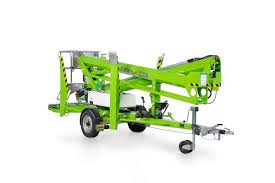
When it comes to installing exterior timber cladding on buildings, scaffolding has traditionally been the go-to method for reaching higher levels. However, with advancements in lifting technology and a growing need for cost-effective solutions, alternatives such as scissor platform lifts and telescopic platform lifts have become viable options for many projects. This article will explore the reasons why scaffolding might not be required for timber cladding installation and how using lifts can save both time and money.
1. The Role of Scaffolding in Traditional Construction
Purpose of scaffolding: Scaffolding is traditionally used in construction for providing a safe and stable platform for workers when performing tasks at height.
Limitations of scaffolding: While scaffolding offers a broad, stable working surface, it often requires a lot of setup, significant manpower, and extra time for assembly and disassembly. In addition, scaffolding may need to be inspected periodically, leading to further delays and costs.
2. Why Scaffolding Isn't Always Necessary for Timber Cladding
Smaller, more maneuverable platforms: Installing timber cladding typically involves accessing vertical surfaces of the building. Scissor lifts and telescopic lifts can easily provide the necessary height without the bulky setup of scaffolding.
Reduced setup and disassembly time: Unlike scaffolding, which can take hours or days to set up and dismantle, scissor lifts and telescopic lifts can be brought to the site, used efficiently, and moved as needed with minimal downtime.
Access to hard-to-reach areas: Lifts can reach areas that scaffolding may not easily cover, especially on uneven terrain or in tight spaces where scaffolding would be difficult to position.
3. The Benefits of Using Scissor and Telescopic Platform Lifts
Installing cladding vertically: This becomes a challenge for the installer because if you have long boards running vertically then firstly, they have to be man handled carefully through the scaffolding and platform boards making sure not to damage the timber. The horizontal scaffold tubes may be too close to the building preventing proper access to the cladding. One person will need to be at the top and another at the bottom. You can only partially fix the board before taking the ladder down to the level below.
Clear view and access: Using a platform lift can also mean that only one person is required to carry out the installation whilst a second person can be working on another part of the building or off a second platform lift which all come in different platform lengths suitable for most projects. Two-man lifts will also speed up horizontal cladding as you will be raising and lowering the platform as you install.
Telescopic lifts that have caterpillar tracks and stabiliser arms: These are ideal if your ground is uneven or a bit soft allowing you safe access to carry out your installation.
Groundworks: If your scaffolding support poles are spanning unfinished groundworks for your waste pipes then once your roofing, facia, guttering and occasionally widows are installed, then that would be the time to strike down the scaffolding.
Depending on the size of the windows some installers would prefer to not have to squeeze windows into position around scaffolding due to the risk of breakages and scratches.
Removing the scaffolding will also allow you to finish off the ground around the building to a sensible stage prior to hiring the platforms as and when required.
Cost savings: Renting lifts for specific tasks can be far more cost-effective than erecting scaffolding for the entire project. The equipment can be rented only for the time it is needed, avoiding unnecessary labor and equipment costs associated with scaffolding.
Installer costs: Remember that the easier and more practical the physical installation is, the more cost-effective the quote will be.
Enhanced safety: With modern platform lifts, workers are provided with a stable and secure platform at the required height. This reduces the risk of accidents associated with traditional scaffolding, such as falls from height.
Increased mobility and flexibility: Both scissor lifts and telescopic lifts are compact, allowing workers to access multiple sections of the building quickly and efficiently. This flexibility is often more practical than scaffolding, which can be cumbersome to adjust once in place.
4. Comparing the Costs: Scaffolding vs. Lifts
Initial investment and rental costs: Scaffolding requires a considerable upfront investment or rental fee, and ongoing costs for labor and time spent assembling and disassembling it. Lifts, on the other hand, can be rented on a daily or weekly basis, giving project managers the flexibility to scale usage based on project requirements.
Labor savings: Using platform lifts often requires fewer workers to operate, and the lift can do much of the heavy lifting in terms of reaching high areas. This can further reduce the overall labor costs compared to scaffolding, which requires multiple workers for setup and maintenance.
Reduced downtime: With scaffolding, work can be delayed if weather conditions or other factors hinder access to the structure. Lifts, however, are quicker to move and can be positioned even under adverse conditions, allowing workers to continue with their tasks without prolonged interruptions.
5. When Scaffolding Might Still Be Required
While lifts offer significant advantages, there may be instances where scaffolding is still the better choice, especially for:
Large-scale buildings where platform lifts may not provide sufficient reach or capacity.
Projects that require extended duration or continuous work at height, where scaffolding provides a stable working environment over time.
Compliance with certain local regulations or building codes that may require scaffolding for safety reasons.
Installing exterior timber cladding doesn't always necessitate the use of scaffolding. By leveraging scissor platform lifts and telescopic lifts, contractors can reduce costs, improve safety, and increase flexibility on site. As technology continues to evolve, it is becoming increasingly clear that lifts provide an efficient and cost-effective alternative to traditional scaffolding, especially for smaller to medium-sized projects. By assessing the specific needs of each project, building professionals can make informed decisions about whether to invest in scaffolding or opt for platform lifts, ultimately saving time and money.





Comments